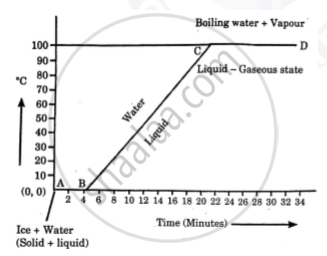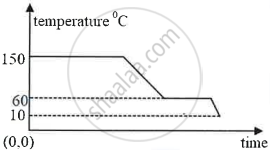Advertisements
Advertisements
प्रश्न
20 g of ice at 0°C absorbs 10,920 J of heat energy to melt and change to water at 50°C. Calculate the specific latent heat of fusion of ice. Specific heat capacity of water is 4200 J kg-1 K-1.
उत्तर
Let Specific Latent heat of fusion of ice = L
Heat required to change ice at 0° C to water 0°C + water 50°C
∴ Heat required = `20"L" + 20 xx 4200/1000 xx (50 - 0)`
= 10,920
Q = 20L + 4200
= 10,920
20L = 6720
L = `6720/20`
= 336 J g-1
संबंधित प्रश्न
State any two measures to minimize the impact of global warming.
What do you understand by the term latent heat?
Which has more heat: 1 g ice at 0℃ or 1g water 0℃? Give reason.
A molten metal of mass 150 g is kept at its melting point 800℃. When it is allowed to freeze at the same temperature, it gives out 75,000 J of heat energy.
- What is the specific latent heat of the metal?
- If the specific heat capacity of metal is 200 J kg-1 K-1, how much additional heat energy will the metal give out in cooling to -50℃?
A refrigerator converts 100g of water at 20℃ to ice at – 10℃ in 73.5 min. Calculate the average rate of heat extraction in watt. The specific heat capacity of water is 4.2 J kg-1 K-1, specific latent heat of ice is 336 J g-1 and the specific heat capacity of ice is 2.1 J kg-1 K-1.
When a liquid is getting converted into solid, the latent heat is ………………………………
Water expands on reducing its temperature below ______°C.
Explain the following temperature Vs. time graph:

What do you mean by the statement?
'The specific latent heat capacity of fusion of ice is 336 J per g'?
What happens to the heat supplied to a substance when the heat supplied causes no change in the temperature of the substance?
When 1 g of ice at 0 °C melts to form 1 g of water at 0 °C then, is the latent heat absorbed by the ice or given out by it?
Why does weather become pleasant when it starts freezing in cold countries?
Explain, why no tracks are left on the ice during ice skating?
1 kg of water is contained in a 1.25 kW kettle. Assuming specific heat capacity of water = 4.2 J/g °C and specific latent heat of vaporization = 2260 J/g, calculate:
(i) the time taken for the temperature of water to rise from 25°C to its boiling point,
(ii) the mass of water which evaporates per minute from the boiling water.
If pressure increases, the melting point of a substance ______.
Write the name.
Products obtained when sugar is heated.
Calculate the total amount of heat energy required to melt 200 g of ice at 0°C to water at 100°C. (Specific latent heat of ice = 336 Jg-1, specific heat capacity of water = 4.2 Jg-1 °C-1)
The amount of heat energy required to melt a given mass of a substance at its melting point without any rise in its temperature is called as the ______.
The diagram below shows a cooling curve for a substance:

- State the temperatures at which the substance condenses.
- The temperature range in which the substance is in liquid state.
- Why do we prefer ice to ice-cold water for cooling a drink?
